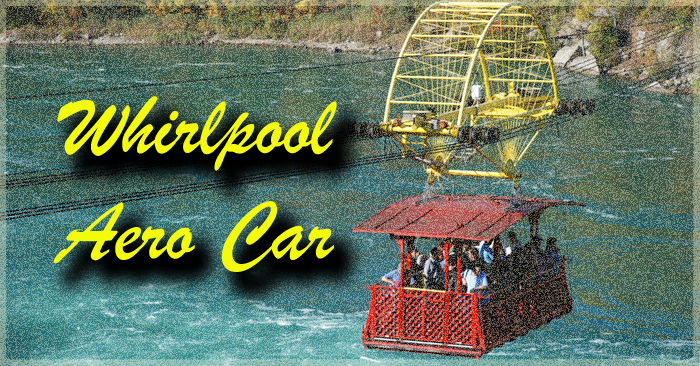
a history
Open Seasonal
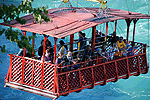 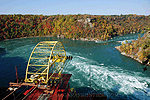
|
February 11, 1916
Passengers Carried across the Whirlpool for the
First Time in Tramway Car
Officials of the company make test journey and report that
they are well pleased with the result - gorge car stops and salutes
with whistle as car reaches station
Niagara Falls, Ontario - February 11, 1916
The first trip across the seething whirlpool of the aerial
tramway was made yesterday afternoon when the passenger car
travelling on six parallel track cables travelled from one terminus
to the other, Colt's Point to Thompson's Point - over the maelstrom
without a hitch.
For a few weeks past, weight tests have been made in connection with
loading up the car with steel etc., but yesterday the car carried
human freight across the Torres system of constant multiple cables
which has been installed for taking tourists on a thrilling trip
over the vortex of water.
Those who made the trip were Gonzolas Torres y Polenco, C.E., Chief
Engineer and Vice President of the Niagara Spanish Aero Car Company
Limited; and Antonio Balzola, President and Secretary Treasurer of
the company; Lewis S. Roy, superintendent in charge of the
construction; J. E. Taylor, resident engineer, representing Wright &
Howard, consulting engineers of Toronto, who were employed by the
Spanish company to adapt their designs to local conditions and who
prepared the plans and supervised the construction.
Nothing was known that the test trip was to be made. The gorge car
stopped and it's whistles screeched out a salutation to the new
tramway and gave gorge passengers an opportunity of seeing it making
it's trial trip.
The officials were highly pleased with the initial trip, which was
made in four and a half minutes but it is planned to permit it to
occupy six minutes by running at half speed part of the time.
Every part of the machinery work perfectly and the officials report
a magnificent view of the wonderful surrounding scenery. It is the
second cableway of its kind in the world and the only one in
America. Work started July 12, 1915 and will be ready for regular
traffic within a few weeks. The cost of the project was nearly
$60,000 of which more than half was taken up by engineering
construction work.
|
In 1913, a group of Spanish businessmen
proposed the building of a cable car across the width of the Whirlpool from Canadian
terminus to Canadian terminus. They negotiated an agreement with the Queen
Victoria Niagara Falls Parks
Commission to design, build and operate a passenger cable car. The permission of the State of New York and
US Government needed to be obtained before construction began because the proposed route
momentarily eclipsed the international border in the middle of the Whirlpool crossing.
The lease was for a term of ten years
with the right of renewal for an additional ten years. The lease included a
term that the Parks Commissioners might purchase the aerocar attraction
after twenty years or at the end of any subsequent ten year period. It was
expected that the tramway would be open by January 1st 1915 but WWI
obstructed those plans.
The Spanish Aero Car was built in
Bilboa, Spain. It was designed by Spanish engineer Leonardo de Torres Quevedo (1852-1937). The
basic design was based upon a similar cable car at Mount Ulia in Spain which carried
fourteen passengers at a time.
The Spanish Aero Car was designed to
travel 1,770 feet (539m) across the Whirlpool from Canadian terminus at Colt's Point (where
the ticket office is located and where passengers embark) to near the Canadian terminal at
Thompson Point, at a height of 250 feet (76 meters) above the surface of the turbulent
waters. The Aero Car has a capacity of 40 persons. It is constructed primarily
of light weight aluminum.
The Spanish Aero Car operates on a back
and forth principal. It is propelled by a single 60 horsepower engine which drives a 7/8
inch (2.23cm) steel looped cable. It is suspended by six - one (1) inch (2.54cm) steel
cables. Each cable is attached to an anchorage at one end while tension is maintained by a
10 ton counterweight at the other end.
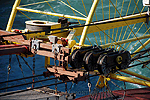
|
Aerial Tramway across the Whirlpool
Formally Placed in Operation Today
Niagara Falls, Ontario - August 8, 1916
After nearly 13 months of construction work the aerial tramway over
that Whirlpool Rapids will be formally opened at 3 o'clock this
afternoon at Thompson's Point Whirlpool Station, which will be
witnessed by the directors and officers of the Niagara Spanish Aero
Car Company, Mayor Clendening and aldermen, prominent engineers,
citizens, press representatives and moving picture men, after which
one of the "newest thrills of Niagara" will be open to the public.
Work was started on the tramway July 12, 1915. Spanish engineers
have constructed the cableway at a cost of $60,000 on a principal
invested by Leonardo de Torres Quevedo, an engineer who has gained
considerable fame in aeronautics. The cable extends from Thompson's
Point, to Colts Point. The cableway is 1,800 feet long and is the
first time that multiple cables have been used for passenger
service. It is the longest and probably the safest scenic tramway in
the world and the features of its design and erection includes
points of engineering interest.
The design of the anchorage was governed largely by the fact that
the cableway was not allowed to cross the tracks of the
International Railway and by the proper order of the Queen Victoria
Park Commissioners that the appearance of the cliffs on neither side
of the whirlpool must be altered and that no towers or structures of
any kind could rise above the level of the tracks of the railway
which runs along the cliff.
The design of the cableway is based upon Spanish patents and the
enterprise has been financed entirely by capitalists in Spain.
The company which was incorporated in Canada, is called the Niagara
Spanish Aero Car Limited, and has issued $110,000 in capital stock;
$30,000 of which was granted for patent rights to the Society's
Estudios Y Obras de Ingeneria de Bilbao, Spain, of which José
Orbegozo, C.E., is president.
Gonzalo Torres y Ploance, C. E., Chief engineer and vice president
of the Canadian Company is the son of the investor of the scheme.
Antonio Balzola is president and secretary-treasurer. Both the
gentleman have resided in the city since the beginning of the work
and have made many friends here. They have quarters at Mr. Goold's
residence, River Road.
The passenger car is suspended from a running gear which travels on
six parallel carrying, or track cables, each of which is fastened
securely at Colts Point. Each track cable is entirely independent of
the others. The breaking of any one of them would not be serious, as
the other cables would support all the weight of the car without
increase in their tension.
The Parks Commission collects an annual rent which increases with
the number of passengers carried, besides a minimum rental of $3,000
a year.
The general contractors for the complete installation were Norman
McLeod Limited of Toronto. J. E. Taylor was resident engineer,
representing Wright & Howard, consulting engineers, Toronto who were
employed by the Spanish company to adapt their design to local
conditions and who prepared the plans and supervised the
construction.
The tramway has been tested with a load of 10 tons and has passed
all government inspections which have been of a severe nature. |
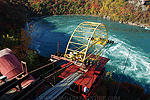
Question: How did they get the
cables across the Whirlpool?
Answer: Small ropes were
attached in increasing diameter to the cables. The ropes were walked on land
around the outer diameter of the Whirlpool from Colts' Point to Thompson
Point. Each rope was then hoisted to the level of the winches which in turn
pulled the cable to their current locations and height.
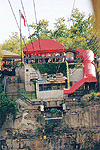
the Whirlpool Aero
Car crossing the Whirlpool approaching Colt's Point where passengers embark/disembark
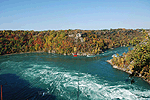
Auxiliary power for the Spanish Aero
Car for the first forty-five years consisted of a small Buick engine.
The Spanish Aero Car began operation on
August 8th 1916. The initial installation cost was $60,000. There has never been an
accident or injury since the Spanish Aero Car began operations.
From 1916 until 1961, the Spanish Aero
car was operated under the management of the Brooker family.
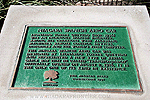 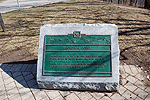
In 1961, the Spanish Aero Car and all
of its assets was leased from the Niagara Parks Commission by A. Blake Robertson. During his ownership, Robertson
installed a system of electromagnetic and a hand operated brakes acting upon a fifteen
inch diameter brake drum. The new brakes automatically stopped and held the Aero Car at
the station or in the event of a power failure. Other improvements included a modern 60
horsepower gasoline engine connected by means of a chain drive and friction clutch
replaced the old auxiliary power system.
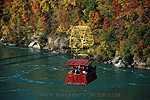
In 1968, the Niagara Parks Commission did not
renew Mr. Robertson's lease to operate the Spanish
Aero Car.
A
Reminiscence by David R. Wood
"I
worked for Blake Robinson on the Aero car for the seasons of 1965,66,67.
(Until Niagara Parks took over the operation) The rights to the land were on
a long term lease. The lease was up! The NPC refused to renew it, but
bought the equipment from Blake. I was quite aware of the circumstances
partly because I lost my summer job as a result of the “takeover”. My father
was a senior manager with the NPC, and because the Park had a “no relatives
as employees” policy at the time, I could not work on the Aero car for my
last summer as a student. Instead I worked for Blake at the “Great Gorge
trip” and the “Age of Flight” restaurant, which was across the street from
the “Great Gorge Trip” (Old Oneida plant building).
Perhaps the most interesting note is that the original “rescue device” for
the Aero car was a two wheeled bicycle device. The wheels ran on one of the
cables. The frame, seats and pedals where below the wheels. The pedals drove
a long chain that turned one of the wheels. (rear one if I remember
correctly) this contraption hung in the equipment room (“cave” as we called
it) all the time I was in the area. I never saw the device in use, but was
told that when the Aero car was inspected (It was licensed as an elevating
device at that time) Charlie (the operator in charge at the time) had to
mount the bike and ride it across to verify that it was a viable means of
rescue. This I am sure would have been a VERY interesting ride.
Another few facts for your notes. When I was there the Buick straight eight
backup motor had been replaced with an 45 horse Wisconsin air cooled motor.
The controller for the electric motor was a controller from a “Streetcar”.
At that time the “capacity” for the car was set at 40 passengers. This
worked fine except for the day those 40 persons were “Hamilton Tigercats”
football team members. The electric motor was not power enough to finish
“docking” the car. The Wisconsin backup motor had to be used to finish
bringing the car into the loading/unloading platform. Because of the
different gearing it was powerful enough.
I
was on the car with one passenger on a day when a thunderstorm came up. THAT
was a great ride."
In 1984, the Niagara Parks Commission
conducted an extensive overhaul of the Spanish Aero Car which included replacing the
wheels, cables and electrical circuits.
The original cables lasted thirty-five
years before being replaced.
In the early spring of each year, the
Aero Car including all mechanics, cables and rescue car are examined and
subjected to rigorous testing before this attraction is opened to the
public.
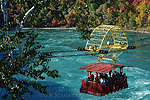
In case of any emergencies, a small
rescue car is kept inside the cave at the Thompson Point terminus. The rescue car can hold
six persons and was installed as a backup unit in 1985. This metal rescue car
has never been utilized since it's installation other than yearly training
sessions held by the Niagara Parks Police.
In the event of a power failure, a diesel
generator can safely pull the main car back to the dock at Colt's Point. If
the main car becomes inoperative, the rescue car would be utilized to travel
along the same cables to the main car to remove any stranded occupants. Four
passengers can be transferred from the main car to the rescue car each time.
Both the main cable car and the rescue car are propelled by a single 60
horsepower engine which drives a 2.23 centimetre (7/8 inch) steel looped
cable. They are suspended by six - 2.54 centimetre (1 inch) steel cables. If
for any reason the engine is not functioning the rescue vehicle can be
propelled manually using a hand cranking system similar to that used in the
operation of a bicycle.
The Spanish Aero Car attracts
approximately 220,000 people each year.
During the Winter of 1999-2000, the
Niagara Parks Commission operated the Spanish Aero Car for the first time on a year round
basis. The Aero car
was specially outfitted for cold and inclement weather with a Plexiglas enclosure to
protect riders from the outside elements. This experiment ended the following
year because of financial constraints and a lack of substantial number of
riders.
In 2004, the Niagara Parks Commission
changed the name of this attraction from the Spanish Aero Car to the
Whirlpool Aero Car.
On September 30th 2010, the engineering
feat of building a cable car over the Niagara River Whirlpool was recognized
when the Whirlpool Aero Car was designated an International Historic Civil
Engineering Work.
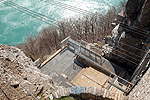 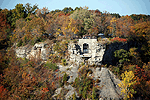
Thompson Point
|
NIAGARA'S LAST MARVEL - TRAMWAY OVER WHIRLPOOL
Now It Is Possible to Take Aerial Journey on Cableway Directly over
Seething Whirlpool Itself - Spanish Company Installs Remarkable
Device, Second of Its Kind in the World - How It Is Constructed
Niagara Falls March 3, 1916
The latest in thrills is a trip across the mighty whirlpool rapids
on an aerial tramway which has just been installed and put into use.
It is the second cableway of its kind in the world and the only one
in America. It was begun on July 12, 1915 and has cost nearly
$60,000.
The design of the cableway is based upon Spanish patents and the
enterprise has been financed entirely by capitalists in Spain. The
Niagara Falls Queen Victoria Park Commission collects an annual
rental which increases with the number of passengers carried,
besides a minimum rental of $3,000 a year.
Spanish Company
The company which has been incorporated in Canada is called the
Niagara Spanish Aero Car Company Limited and has issued $110,000 in
capital stock: $30,000 of which was granted for patent rights to the
Society Estudiois Y Obras de Ingeneria of Bilboa, Spain, of which
Jose Orbegozo C.E., is the president.
The system is the invention of Leonardo de Torres Quevedo, an engineer of
great prominence in Europe.
Cost about $60,000
The cost of the Tramway was nearly $60,000 of which more than half
was taken up by engineering construction work and materials
exclusive of the loading platforms and car, both of which were built
in Spain. The cliff that encloses the whirlpool is a part of the
riverbank on the Canadian side so that both ends of the cableway are
on Canadian territory. But the boundary line between New York State
and Ontario forms an acute angle which is intersected by the
cableway about 60 feet within the apex. The cableway therefore
crosses a small portion of New York State. As the bed of the river
is owned by the State and the water by the Federal Government,
permission had to be secured from Washington and Albany, after they
had the sanction of the Province of Ontario and the Niagara Falls
Queen Victoria Park Commissioners.
Conditions were that the appearance of the cliffs on either side of
the whirlpool must not be altered and that no towers or structures
of any kind were to rise above the level of the tracks of the
International Railway which runs along the bank and the cable was
not allowed to cross the tracks of the Niagara Beltline, hence the
anchorage was so designed to avoid that.
Car Is Suspended
The passenger car is suspended from a running gear which travels on
six parallel track cables, each of which is fastened securely at
Colt's Point.
At the other terminus, Thompson's Point, each track cable passes
over a grooved sheave and is fastened to a counterweight or
stretcher. These six counterweights are boxes 12 feet high by 6 feet
7 inches wide by 11 inches deep made of riveted steel. Each box
contains four cast iron pieces of 195 pounds each and 200 pieces of
90 pounds each, making a total load of 18,780 pounds, which with the
weight of the box itself makes 10 ton counterweights for each track
cable.
The boxes move up and down freely in steel guides. A sudden load
thrown into the track cables would cause the boxes to rise and the
cable span to sag, but the tension in each cable is 10 tons,
regardless of the load on the passenger car. The tension in the
track cables depends solely upon the counterweights. The track
cables are 1 inch crucible steel rope, made up of seven round
strands surrounded by 16 locked coil strands. As these are too stiff
to bend over the sheaves at Thompson's Point, each one is fastened
by a standard socket, 10 feet in front of the sheave to a 1 1/4 inch
monitor plow-steel cable made up of six strands of 19 wires each, in
these latter cables are bent over the sheaves and fastened to the
counterweight boxes.
Bent around Block
At Colt's Point each track cable is fastened by a standard threaded
cleavis and socket to a 2 inch rod. These 6 rods are bent around a
concrete block weighing 741 tonnes, which is built into the face of
the cliff and are fastened securely at the bottom of the pits, which
are left open to permit inspection at any time.
Each track cable is entirely independent of the others. If one broke
the other cables would support all the weight of the car without any
increase in their tension. The car will provide seats for 24
passengers and standing room in a raised area in the centre of the
car for 21 more, besides the conductor. The weight of the car empty
is 3 1/2 tons, fully loaded 7 tons. It is 10'-10" wide, 24 feet long
and 23 feet high. It was manufactured complete in Spain and
assembled here.
The car is propelled by a 7/8 inch 6 inch x 19 inch plow-steel
traction cable, fastened to one end of the car. This cable passes
over a sheave on Colt's Point, runs back across the whirlpool in
front of the Thompson's Point station and to the driving station.
The eight-foot driving sheave is turned by a 75 horsepower, three
phase, 440 Volt, 480 RPM Westinghouse motor, through a 30 to 1
Hindley worm gear, giving a speed to the car of about 400 feet per
minute when the controller is at full speed. The trip can be made in
4 1/2 minutes, but it is planned to have it run 6 minutes, at half
speed part of the time.
Extra Gas Engine
To provide against breakdown of the motor or interruption in the
power supply, there is a clutch in the driving shaft by means of
which the motor can be disengaged and a 5 hp Gray gasoline engine
engaged, both through a worm gear and through sprocket wheels.
One thousand cubic yards of earth and 2,500 cubic yards of rock were
excavated for the two stations.
The station at Thompson's Point is cut out of solid rock and lined
with concrete and buff tapestry brick. Two flights of concrete steps
provide entrance to an exit from the landing platform. The station
is 29 feet high, 56 feet long and 37'- 9" wide overall. At the
opening of the station there is a horizontal steel platform 9'-10"
long by the full width of the opening and is hinged. At the outer
edge of the short platform there is hinged another platform 38 feet
long extending over the edge of the cliff. The latter platform is
suspended from the track cables by wire ropes and pulleys at the
outer corners and at the hinged corners, each rope being fastened to
three pulleys, one on each of the three track cables. All four ropes
are of the same length, so that the long platform always hangs
parallel to the track cables, whatever inclination the latter may
take. The four ropes are of such length that the platform clears the
bottom of the cars by 6 inches, therefore the car always comes right
onto the platform. The platforms are guarded by the railings. At
Colt's Point the landing extends from the anchorage and two flights
of steps lead up to the ground.
An automobile control stop is provided at each terminus which stops
the car without jar within 4'-1".
The work of placing the cables was done the cold weather. After the
traction and track towers and sheaves had been erected, a very long
rope was carried around the face of the cliff from Thompson's Point
to Colt's Point. This rope was then hoisted over the tops of the
trees until it could be pulled taut from point to point. A half inch
wire rope was pulled across with the aid of a hoisting engine and
then the 7/8 inch traction cable was pulled into place. The traction
cable was used to haul the track cables across. The strength of the
track cables is 22,000 pounds each, allowing for bending over
sheaves, and the working tension is 20,000 pounds. There are two
limit switches placed at each terminus. The first is always struck
by the floor of the car and affects the controller, so that the
power is turned off and cannot be turned on again in the same
direction and so jam the car against the station. Of the second
switch is only hit when the first fails to operate and when the
motor man fails to turn off the controller, and when the pneumatic
cylinder does not bring the car to a stop. The second switch acts
directly upon the circuit breaker, bringing the car to rest within 3
feet and without letting it come within dangerous distance of the
station.
Everything has been installed for safe transportation, and the
engineers of the company are now contemplating a mountainous
installation with two spans each over a mile long. The only previous
installation of the system is in San Sebastian, Spain, for
transportation of tourists across a gorge from trolley terminus to
an otherwise inaccessible view-place and a casino overlooking the
Bay of Biscay. The span there is 919 feet, with a rise of 92 feet.
It has been in successful operation for six years, carrying as many
as 26,000 passengers in a single season.
While the construction work here has been going on it has at crowds
of people, and no doubt when in operation will be a Mecca for
thousands of tourists who yearly visit the scenic surroundings of
the Falls. |
|
Woman Hurls Self to Death
in Whirlpool
Plunges from Aero Car into Gorge at Niagara
August 12, 1934
Mrs. Ruth L. Hyde, age 30, wife of William Hyde, age
87 of Bradford Pennsylvania committed suicide today by jumping from
the sightseeing cable car as he crossed the Niagara Gorge, 250 feet
above the whirlpool rapids. Family members indicated there were no
known reasons for her suicide. Her husband thought that she had gone
home for a visit.
At 3:45 PM, the pretty red haired woman entered the
cable car at Niagara Falls Ontario. She was seen by her herald
Brooker Senior, cashier and his son, herald Brooker Junior operator
of the car. On the platform she handed her purse to young Brooker.
She stepped into the steel basket of the sightseeing
cart and sat beside Arthur J. McKinley of Niagara Falls Ontario.
McKinley had his five-year-old daughter Catherine beside him. As the
woman entered the car she lit a cigarette from which she drew short
quick puffs. The child laughed at the swirls of smoke around the
woman's head.
The car swung out over the gorge. In a few minutes
the dangling basket reached the middle of the river at the lowest
point of its sagging cables.
The woman threw out her cigarette, quickly stepped
up on her seat and plunged headlong into the canyon.
Horrified, McKinley watched her body tumbling over
and over as it plunged into the swirling waters of the whirlpool.
There was a short splash in the body disappeared.
McKinley and his daughter were the only two of the
14 remaining passengers in the sightseeing basket who saw her leap.
He notified the young Brooker.
Quickly returning to the starting point of the cars
quarter-mile travel, Brooker notified Canadian provincial police.
The woman's purse was opened and it was an
automobile driver's license in the victim's name. There was also a
letter addressed to Mr. Hyde. Police opened it but refused to
divulge its contents except that in it Mrs. Hyde said her car could
be found in Niagara falls on the American side.
|
Helicopter Strikes Cable Wires
May 29, 1989
A sightseeing helicopter struck the wires supporting
a moving cable car about 200 feet above the Niagara River, but no
injuries were reported.
Canadian aviation safety Board teams were expected
to arrive today to investigate last evening's accident, which
occurred above the churning Whirlpool Rapids.
The Niagara Falls, New York based helicopter
carrying three tourists and Pilate Mark Felderstein passed within
250 feet of the Spanish Aero Car, struck the cables and sheared off
its landing gear.
The impact swayed the cable car that was carrying 17
passengers, but it returned safely to its base. Felderstein landed
the copter safely on a golf course.
Cable car tour guide Roger Barnsley said he noticed
the low-flying craft for several minutes before the impact.
"I was thinking it was very odd for him to be flying
down that low," Barnsley said. "Nobody's ever down that low. The
next thing we know, there was this impact and the landing gear just
shattered into 1 million pieces and drop down into the gorge. It all
happened in seconds."
Barnsley said the cable car swayed for perhaps half
a minute but no one was in danger of being tossed from the open-air
coach and no debris came near the car.
"I thought he [the helicopter pilot] was gone, but
he pulled it back up. It was amazing he can control it so well,"
said Barnsley.
Felderstein piloted the craft about 100 yards in
length to the whirlpool golf complex and allowed the passengers to
jump a few feet to the ground before the helicopter landed safely on
the 10th fairway.
Scott B. Hughes, General Manager of Rainbow
Helicopters, said the 25-year-old Felderstein has been employed by
the company for about four months and has three years flying
experience.
|
|
NIAGARA
FALLS THUNDER ALLEY NAVIGATOR |
|
|
|
|
SITE MAP |
Date last updated:
August 14, 2016
THANK
YOU FOR VISITING
Niagara
Falls
WHIRLPOOL
AERO CAR
(Spanish Aero Car)
a
history
page
|












